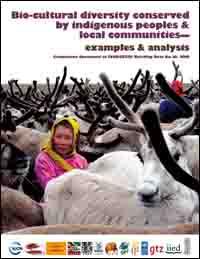Bio-cultural diversity conserved by indigenous peoples and local communities : examples and analysis

Indigenous conservation territories and areas conserved by indigenous peoples and local communities — ICCAs for short — are the subject of an IUCN/CEESP Briefing Note launched at CBD SBSTTA in May 2010. This larger document provides the examples and analysis underlying the policy advice contained in that Briefing Note. The document can be read in conjunction with the Briefing Note or as a stand-alone, as main concepts are described again here. Although their existence is as old and widespread as human civilisation itself, ICCAs have emerged only recently as a major phenomenon in formal conservation circles. International policies and programmes, notably those of the International Union for the Conservation of Nature (IUCN) and the Convention on Biological Diversity (CBD), encourage today all countries to recognise and support ICCAs as examples of effective governance of bio-cultural diversity. It is clear, however, that such recognition and support need to be carefully tailored, and cannot be improvised. IUCN/CEESP's Briefing Note no.10 and this document of complementary resources offer advice about that, addressing governments, civil society organizations, indigenous peoples and local communities engaged in collaboration, support and joint learning about ICCAs.
Includes bibliographic references. Available in separate French and Spanish language versions. Companion document to IUCN/CEESP Briefing Note no. 10, "Strengthening what works: recognising and supporting the conservation achievements of indigenous peoples and local communities" (http://www.iucn.org/dbtw-wpd/edocs/2010-047.pdf).
Keywords:
Broad subject:
Call number:
Record updated: 2022/03/15
